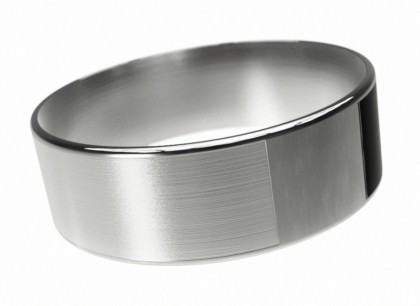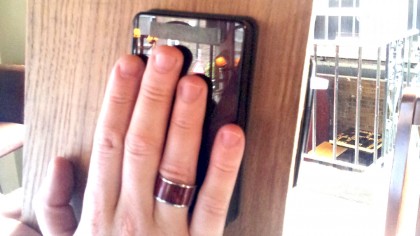How high-fiving your front door can let you can ditch the keys
Open doors and start cars with a simple fist bump
For example, if you want to pass on your Twitter address – a public function – you'll need to use a closed fist to expose the outer side of the ring. If you want to unlock your door – a private function – you'll need to use an open palm gesture.
So this basically means you'll be fist bumping another person's phone to connect on Twitter, and high fiving your front door to gain access - which will appeal to some people and put others off.

Of all the possible uses, it's unlocking doors that has initially captured people's imagination when you speak to them about the NFC ring.
You'll obviously need an NFC enabled digital door lock for it to work, which can be picked up for £223 ($249 US, $276 AUS). It's as simple as touching the designated area on the door and it unlocks. This 'automated home' concept is popular with futurists, but it does present some security problems.
The ring utilises the private underside function that's not readable to others to unlock doors, but naturally concerns have been raised over the readability of the ring and people possibly hacking your door.

Unlocking doors
TechRadar spoke to Tony Anscombe, senior security evangelist at AVG security who raised concerns over how safe the ring actually is:
"[If you look at security researcher] Charlie Miller's research last year, he revealed the weaknesses in NFC technology through two demonstrations, one on a mobile device and the other a hotel room key.
Sign up for breaking news, reviews, opinion, top tech deals, and more.
"The basic flaw in a hotel key is that someone can replicate the device by being near it and reading the information it holds.
"Potentially this same 'hack' could also occur with a ring if someone places a device to take its information in a location where you often place your hands – perhaps a door handle or bar, for example."
Inventor McLear refutes the idea that the device is unsafe. He explained to TechRadar that the read distance of the ring is 1mm, which is purely for security reasons, meaning it's unlikely that anyone would be able to take data from your ring without physically touching you.
He also said that the inlays (readable sides of the ring) are programmed to generate cross talk, so it's impossible to tell which side of the ring is delivering which bit of information.

Although safeguards are in place, there is still the basic issue of theft, Anscombe explained:
"The concept of a proximity-based token (whether a ring, badge, key ring, or whatever convenient device we decide to carry) has many potentially positive uses.
"However, there is one other fundamental security issue that depends on its implementation: as a single factor authentication device, in some situations it would not be enough to ensure complete security.
"What happens if it is stolen and is the only thing needed to open your house and it falls into the wrong hands and potentially leaves your home easily accessible by criminals?
"For NFC gadgets to become a viable way to hold personal data securely, a second authentication process must be integrated."
The competition
This concept is clearly becoming more popular since larger, well known manufactures are starting to jump on the NFC train. David Herbert, head of marketing for lock makers Yale told us that devices like the NFC ring were firmly on the company's radar, and that they, along with smartphones, were the kind of thing that would take the lock-maker's business to 'the next level'.
Motorola, too, is working on a PIN NFC free clip that can be worn around the wrist and used to unlock your mobile, and, theoretically, anything else you programme it to do. Does McLear think these devices are competitors to the NFC ring, or complementary?